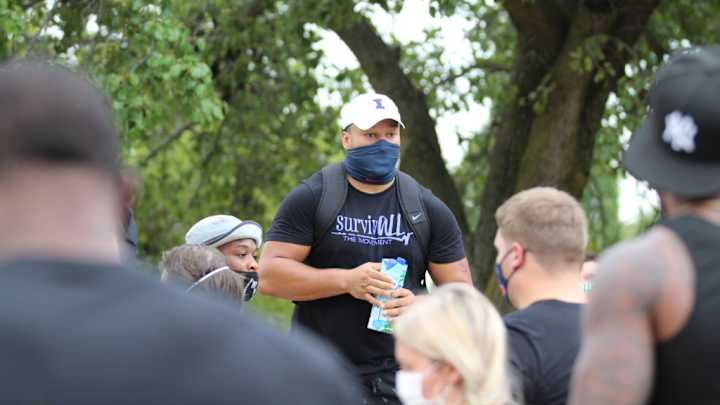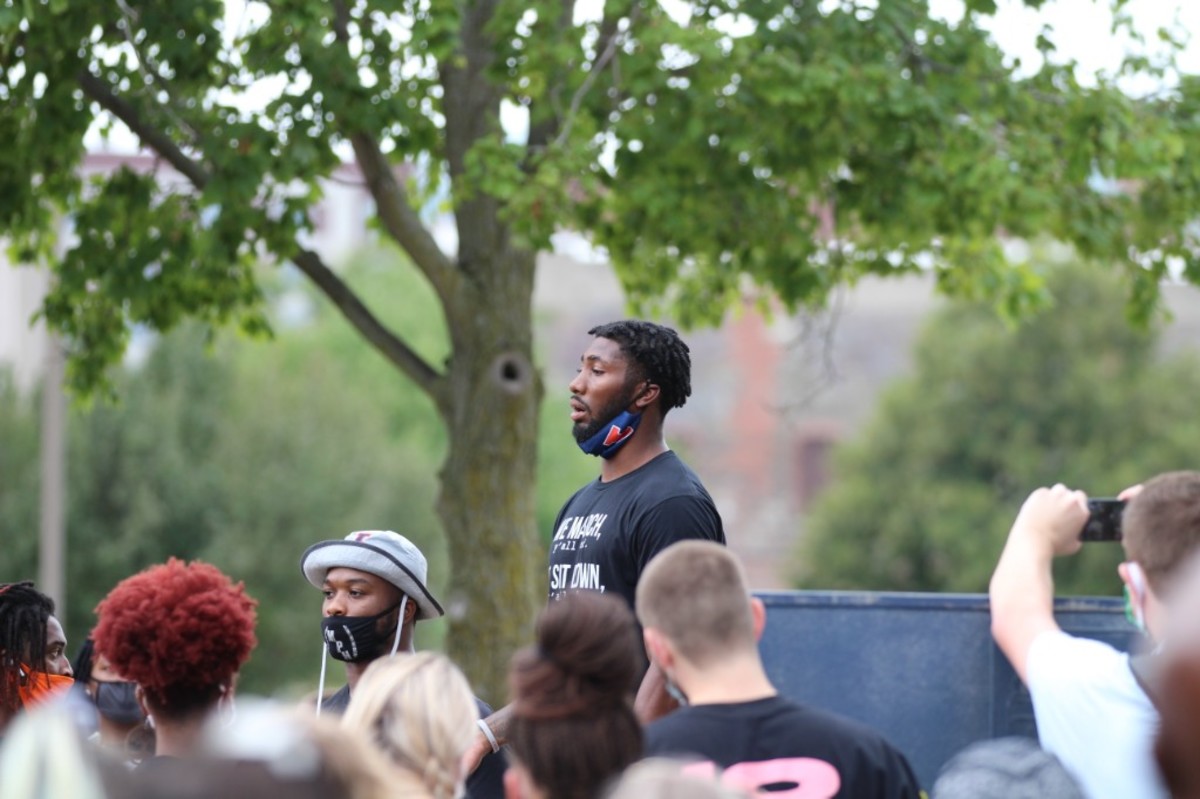How Social Media Created A BLM Protest Led By Illini Football Players

CHAMPAIGN, Ill. -- Kendrick Green might just be remembered most on the University of Illinois campus for what he did while Big Ten football was shut down.
Green needed only a few days to begin the organization and planning, along with several other of his Illini football teammates, for a peaceful protest rally against police brutality and systemic racism that occurred Monday.
“Social media is a powerful thing,” Green said. “Just one or a few tweets and here we are with more people coming and coming.”
The junior offensive guard from Peoria led hundreds of people in a protest crowd Monday of different races, genders, ages and backgrounds for an organized walk down First Street in a one-mile march from to the Grange Grove tailgating area just outside Memorial Stadium to the Champaign Police Department. After seeing athletes speaking out about police brutality and racism at the University Nebraska and University of Tennessee in recent days following the police shooting of Jacob Blake in Kenosha, Wis., Green used group chats with his teammates on Twitter and Facebook to organize a plan of what to do on their campus.
“I never thought something like this would take this much planning but the last three days I was on the phone so much with Champaign police, my coaches, our athletics director Josh Whitman, media personnel wanting to know the plan,” Green said. “It’s weird we’re supposed to be in meetings or on the field getting ready to play whenever that comes but we decided to step out here and allow the community to come together.”
Join my brothers and I tomorrow! Wear a mask. CHANGE WILL COME! pic.twitter.com/7hLfJBVgc7
— Kendrick J. Green (@The_fridge53) August 31, 2020
Green then reached out to his head coach Lovie Smith and athletics administration personnel at Illinois to see if they’d be willing to participate in their protest march. The university was happy to help the players set up a protest route and get Champaign and University of Illinois police department officers to clear traffic from the approximately 1.5-mile walking route from First Street to the police department building and back to Grange Grove.
“Today is just an opportunity for a community to come together and really raise awareness for such a great cause,” Green said. “It’s an everyday thing. It’s a real problem in our society. It needs to be addressed. Rome wasn’t built in a day. This is a small step, but it’s a step in the right direction.”
As hundreds of protesters chanted down the 30-minute walking route and then gathered in the parking lot of the city’s police building, Green and the crowd knelt in prayer, and then for several minutes of silence before making the route back to Grange Grove.

The protest participants included athletics director Josh Whitman, Smith, men’s basketball head coach Brad Underwood, assistant basketball coaches Orlando Antigua and Ronald “Chin” Coleman, softball head coach Tyra Perry and soccer head coach Janet Rayfield. Several players from the Illini football and men's basketball teams were present along with several other campus sports in the protest march.
One of the Illinois players who helped Green with the planning of the protest route was senior cornerback Nate Hobbs. Hobbs, an All-Big Ten honorable mention selection last season by the league’s media panel, was involved in protests this summer in his hometown of Louisville, Ky., after the police shooting and death of Breonna Taylor’s death happened in that particular city.

“I don’t care what anybody says. Love will always be stronger than hatred,” Hobbs said while standing on a bench outside the Champaign police department building. “And this right here is love.”
𝗟𝗢𝗩𝗘 🧡 pic.twitter.com/0Ik2axikt0
— Illinois Football (@IlliniFootball) September 1, 2020
Smith, who has already had his Illini team back on the practice field in just helmets, jerseys and shorts this week, has publicly always supported and encouraged his Illinois players to be part of social movements on their college campus as a form of interacting with the entire student body and community of Champaign-Urbana.
In a NBC Sports interview with Mike Tirico on June 5, 2020, Smith shared a message he’s told his players since taking the job at Illinois.
“I talk to our players about you have the right to protest. That's great,” Smith said. “That's what college life is all about too. In a peaceful manner. But then what else do you do? And that's where we are right now...What I'm going to insist on, first off, all of our guys register to vote. But that's just a part of it, registering to vote. Be informed. If you don't like what's going on right now, and we in America have acknowledged that we don't like what's going on right now, we have to look at first (to) our leader. The policies that he has in place. Congress, local government, this is how you have true change. And for us, it's going to get back to making sure people are informed.”
Green, who is considered one of the best interior lineman in the Big Ten Conference, is hopeful his contribution Monday to the conversation surrounding racial equality is felt and remembered on his college campus far beyond anything he and his teammates attain on a football field.
“We’re athletes (and) we have a platform in our community, especially here at the university,” Green said. “I feel like that speaks volumes. We need to use our platform in a right, positive way and this is a great way to do it. I feel like we should have done something like this a long time ago.”
